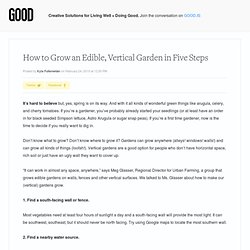

Herbs. Medicinal Herbs & Plants. How to Grow an Edible, Vertical Garden in Five Steps - Cities. It’s hard to believe but, yes, spring is on its way.

And with it all kinds of wonderful green things like arugula, celery, and cherry tomatoes. If you’re a gardener, you’ve probably already started your seedlings (or at least have an order in for black seeded Simpson lettuce, Astro Arugula or sugar snap peas). If you’re a first time gardener, now is the time to decide if you really want to dig in. Don’t know what to grow? Don’t know where to grow it? “It can work in almost any space, anywhere,” says Meg Glasser, Regional Director for Urban Farming, a group that grows edible gardens on walls, fences and other vertical surfaces. 1. Most vegetables need at least four hours of sunlight a day and a south-facing wall will provide the most light. 2. A local, dependable, water source is one of the most critical components—without it you will need to consider another site. 3. 3.
You can start with seeds or seedlings but if you’re starting in later spring, use seedlings. 4. Bonus tips! Dandelions. By Anita Sanchez Whether you love them or hate them, dandelions are among the most familiar plants in the world.

They're one species that just about anyone can identify at a glance, as familiar to humans as the dog. Dandelions are, quite possibly, the most successful plants that exist, masters of survival worldwide. Nowadays, they're also the most unpopular plant in the neighborhood – but it wasn't always that way. Only in the twentieth century did humans decide that the dandelion was a weed. To get us back on the right dandelion track, here are 10 dandelion-related facts. 1. 2. 3. 4. 6. 7. 10. Dandelions probably will never be eradicated, but we can learn to be more at ease with dandelions and other wild things – and maybe even to love them a little.
Why Dandelions Are the New Kale. Kale has received plenty of press in the last decade.

Good for kale. Good for our bodies. Kale is actually a “gateway” leaf into the world of green. Green your diet, and you will naturally start to pay more attention to plants with leaves. Leaves transfer life force energy by infusing chlorophyll into your red blood cells. Humans Used to Eat Green As a species we’re in a “remembering” phase of our health evolution. Inner & Outer Ecosystem Theory There is a holistic gorgeousness to the situation here: as we green our diet with growing complexity, we evacuate the toxic rubbish from our cells.
Externally, we begin to notice more variety in the plants in the supermarket, our yard and our ecosystem. The Dandelion Effect I’ve seen the dandelion effect emerge like this: you do your first body cleanse and start drinking green juice or green smoothies. The light bulb goes off. Wait, you think. Greens Are Free I’m glad you’ve started eating green. The Health Benefits of Dandelions. Vermicompost - A Living Soil Amendment.